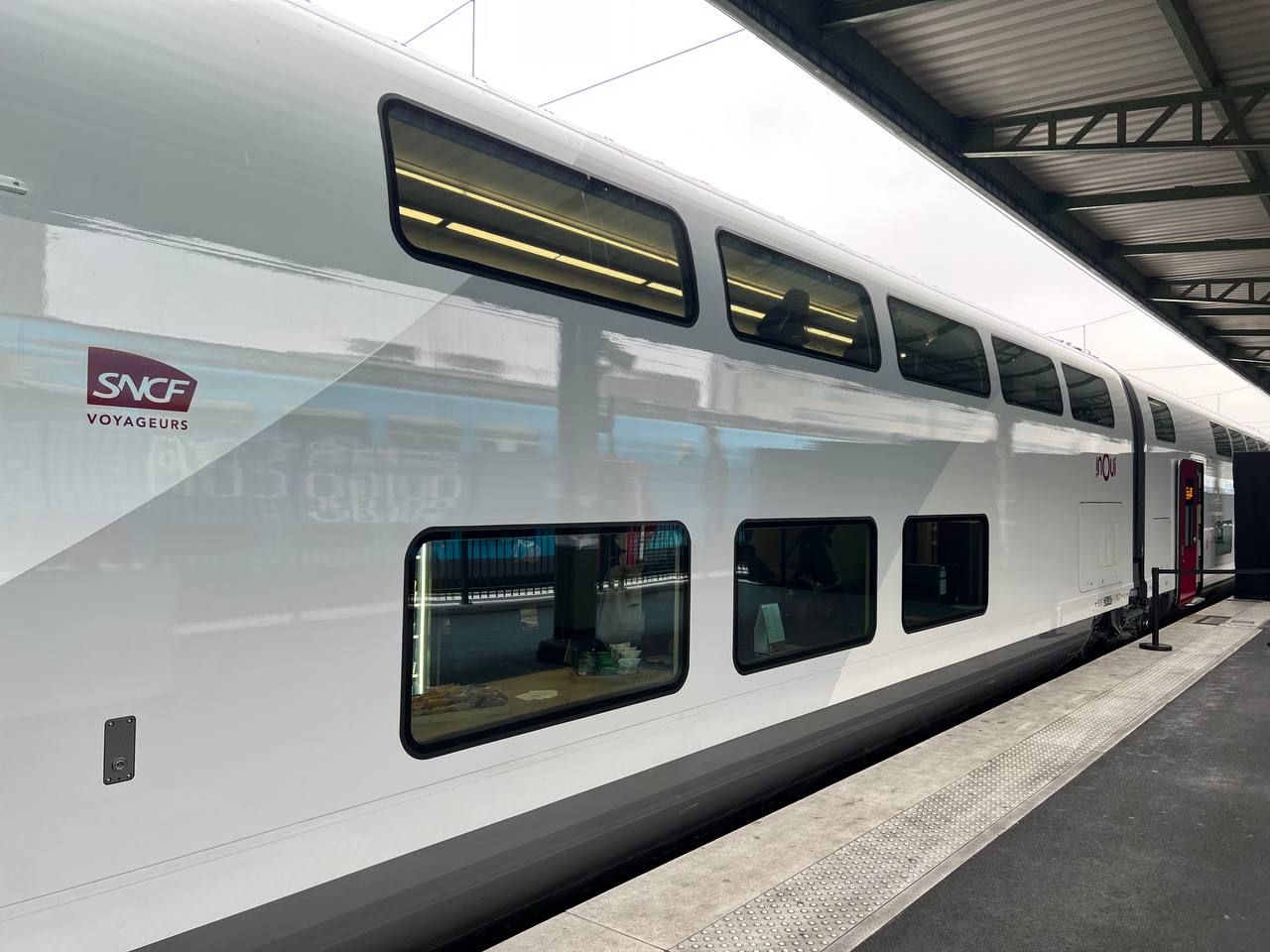Is it a problem with TGV-M not meeting the accessibility requirements, or separate problems with accessibility, and the TGV-M?Problems with accessibility guidelines and TGV-M.
-
Our new ticketing site is now live! Using either this or the original site (both powered by TrainSplit) helps support the running of the forum with every ticket purchase! Find out more and ask any questions/give us feedback in this thread!
You are using an out of date browser. It may not display this or other websites correctly.
You should upgrade or use an alternative browser.
You should upgrade or use an alternative browser.
Proposed new Channel Tunnel services discussion
- Thread starter TheWierdOne
- Start date
Sponsor Post - registered members do not see these adverts; click here to register, or click here to log in
R
RailUK Forums
HS2isgood
Member
They made some weird system to move the floor level? I don't remember and I definitely lack the technical knowledge to comment much more in depth. But yeah it's likely it'll be TGV-M. That raises the interesting point of where the remaining e320 would be. Also, as they're 200 m sets, replacing all the e300, PBA and PBKA's, it's actually a net increase of... two 200 m trainsets, not much. Even though they should allow more service, as they intend to reduce turning time at termini and they've cut all service south of Paris/MLV.
Snow1964
Established Member
The problem is explained in detail in this article that I have just found.Is it a problem with TGV-M not meeting the accessibility requirements, or separate problems with accessibility, and the TGV-M?
Platforms normally 550mm or 760mm, but there is a door threshold at 617mm and a floor height of 300mm. It also seems the wheelchair lift equipped vehicles have active suspension and can be raised a bit when stationary to reduce platform-train height differences

The accessibility problems with Alstom's new TGV-M train - with implications for future Channel Tunnel operators - #CrossBorderRail
There is no way to sweeten this: my original conclusion that Alstom’s Avelia Horizon (known as TGV-M with SNCF) is not legal at higher station platforms outside France was incorrect. Because transparency and correcting my errors matters to me, you can read the original blog entry in full here – […]
crossborderrail.trainsforeurope.eu
Last edited:
Trainbike46
Established Member
This might be somewhat controversial, but if the TGV M poses such issues for accessibility on services that encounter both 550mm and 760mm platforms, then maybe a different train design makes more sense, whether it be from Siemens, Alstom, or even some other manufacturer.
Last edited:
Trainbike46
Established Member
So, something like the eurostar e320? That would make lots of sense. Maybe too much for Eurostar!Surely a single deck flat floor unit with distributed traction is the most straightforward choice?
For non-high-speed trains there are also trains that have a mix of double and single deck coaches, would such a design make sense for a high-speed operation? Simply have the accessible seats and wheelchair places in the single deck sections.
They (eg the Omneo Premium) are ingenious, I agree - I wonder how you would cope with the aerodynamics at 330km/h though?For non-high-speed trains there are also trains that have a mix of double and single deck coaches, would such a design make sense for a high-speed operation? Simply have the accessible seats and wheelchair places in the single deck sections.
There's still the issue of two different platform heights to cope with.
Trainbike46
Established Member
That should be doable - the region 2N / Omneo premium already gets close by using the roof of the single-deck cars to install equipment. Or just have VERY tall ceilings on the single deck carsThey (eg the Omneo Premium) are ingenious, I agree - I wonder how you would cope with the aerodynamics at 330km/h though?
The two main ways for dealing with the platform heights are:There's still the issue of two different platform heights to cope with.
- offer level boarding at 760mm (and a 21 cm step up 550mm, using a ramp at 550mm stations)
- have separate entry doors on the accessible coach, one for use at 550 mm stations, one for use at 760 mm stations, and use an internal fixed ramp to get to/from each door to the wheelchair spaces (I believe DB uses this approach on some rolling stock?)
martin2345uk
Established Member
Why did HS1 build its international platforms at a different height to those in France..?
HSTEd
Veteran Member
- Joined
- 14 Jul 2011
- Messages
- 18,590
I don't have access to the original documents, but likely to make it easier to board trains designed for 915mm height platforms.Why did HS1 build its international platforms at a different height to those in France..?
760mm is the higher of the two permitted TSI heights (leaving aisde national special heights like 915mm or the Dutch one)
Trainbike46
Established Member
They followed the standard of Belgium, the Netherlands and western Germany (760mm). Why mainland europe has decided to standardise on two different levels (550 and 760mm), I do not know.Why did HS1 build its international platforms at a different height to those in France..?
Eurostar would have to be able to use both heights in any case, so there isn't really a massive reason to prefer the French height on HS1.
The old dutch height was 840mm, but the Netherlands is changing to 760mm. Fortunately they are pretty close, so both heights existing at the same time is not really an issue.I don't have access to the original documents, but likely to make it easier to board trains designed for 915mm height platforms.
760mm is the higher of the two permitted TSI heights (leaving aisde national special heights like 915mm or the Dutch one)
Many new trains have internal floor heights that offer level boarding at 760mm platforms, e.g. the NS FLIRT with 780mm internal floors.
Last edited:
France probably decided on 550mm for new HS platforms because of the extent of TGV running at routes' extremities on classic infrastructure, most of which traditionally had very low platforms. That's the case in much of southern Europe, even including south Germany and many rural areas. Rebuilding to anything higher than 550mm at so many stations would be impractical, so the lower option has become locked in across a wide part of Europe. That will inevitably cause problems at and across interfaces, particularly for long-distance and international trains.
In France many of those original classic segments have since been replaced by LGV extensions, but even now there's still a fair amount of classic running, partly through a policy of serving as much of the country as possible, even if only with a tiny handful of daily trains, but also where routes are predominantly LGV, HS trains still often share existing platforms and final approaches with classic trains at major city terminals.
It could make sense for LGV Nord to have 760mm platforms at Paris and Lille, as the majority of HS trains on this line are former Thalys on the Benelux/Germany route and London Eurostars that all have to cope with higher 760mm platforms once outside France. Standardisation could allow future level boarding on this northern European HS subnet. There are some longer-distance TGV services from Lille to various other direct destinations in France, but they could plausibly use the adjacent classic terminus instead if there was a platform height issue at the HS station.
Spain has standardised on 760mm for HS, like northern Europe, though much of the traditional network has very low platforms like France. Interrunning between HS and classic networks due to different track gauges is limited but occurs on some routes using gauge-changing rolling stock. International HS trains between France and Spain will face similar compatibility challenges over platform height.
In France many of those original classic segments have since been replaced by LGV extensions, but even now there's still a fair amount of classic running, partly through a policy of serving as much of the country as possible, even if only with a tiny handful of daily trains, but also where routes are predominantly LGV, HS trains still often share existing platforms and final approaches with classic trains at major city terminals.
It could make sense for LGV Nord to have 760mm platforms at Paris and Lille, as the majority of HS trains on this line are former Thalys on the Benelux/Germany route and London Eurostars that all have to cope with higher 760mm platforms once outside France. Standardisation could allow future level boarding on this northern European HS subnet. There are some longer-distance TGV services from Lille to various other direct destinations in France, but they could plausibly use the adjacent classic terminus instead if there was a platform height issue at the HS station.
Spain has standardised on 760mm for HS, like northern Europe, though much of the traditional network has very low platforms like France. Interrunning between HS and classic networks due to different track gauges is limited but occurs on some routes using gauge-changing rolling stock. International HS trains between France and Spain will face similar compatibility challenges over platform height.
Last edited:
Snow1964
Established Member
DfT announcement : deal with Switzerland for direct rail link

 www.gov.uk
www.gov.uk
Millions of passengers could benefit from quicker, greener and more convenient travel across Europe as the Transport Secretary signs a landmark agreement to progress a new direct rail link to Switzerland.
A Memorandum of Understanding (MoU) signed today (9 May 2025) between the Transport Secretary, Heidi Alexander, and Federal Councillor, Albert Rösti, will lay the groundwork for future commercial services that could boost tourism to the UK, support jobs and businesses and strengthen cross-border trade.
This landmark agreement, signed today at London St Pancras Station, signifies the government’s ambition to boost sustainable transport links across Europe and unlock the significant economic, social and environmental benefits a direct rail connection brings.
The move will help formalise cooperation between the 2 governments, building on industry efforts, to address the barriers to establishing direct rail services, in particular the need to establish border controls and meet Channel Tunnel safety rules.
It will also support the industry’s existing plans to realise long-term ambitions for enhanced rail connectivity between the UK and central Europe.

Transport Secretary forges landmark deal to progress new Swiss rail link
Direct rail link between UK and Switzerland could boost tourism and grow our economy, while offering a greener option for passengers.
Trainbike46
Established Member
There is also a specific thread for this announcement: https://www.railforums.co.uk/threads/london-to-switzerland-direct.285973/DfT announcement : deal with Switzerland for direct rail link

Transport Secretary forges landmark deal to progress new Swiss rail link
Direct rail link between UK and Switzerland could boost tourism and grow our economy, while offering a greener option for passengers.www.gov.uk
